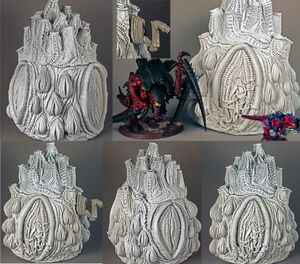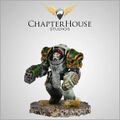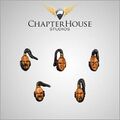ChapterHouse Studios
| ChapterHouse Studios | ||
|---|---|---|
| Website | http://chapterhousestudios.com/ | |
ChapterHouse Studios was a miniatures company that produced miniatures and bits meant to be used with Games Workshop's Warhammer 40,000 and Warhammer Fantasy lines. Rather than dancing around the issue and saying "compatible with major brands of 28mm miniatures (wink, wink)", ChapterHouse's products were directly named and organized by what GW factions and models they were meant to go with. Needless to say, this led to less than desirable consequences when Gee Dubs found out about this.
As of fall 2018, the Chapterhouse site seems to have been shut down once again, with links no longer working and the site no longer showing up in google search. It's unclear whether this is due to poor sales, continued legal fallout, or competition from the host of bigger, better, and savvier 3rd party manufacturers that have been rising in the last few years, but it seems that it might finally be over for Chapterhouse once and for all.
Lawsuit from Games Workshop[edit]

Games Workshop got fed up with this and filed a lawsuit against them when they started making models for units that GW had named in their codices but not depicted in any art or models, most notably the Tyranids' Mycetic Spore. The lawsuit went on for years, but finally ended mostly in ChapterHouse's favor -- since Games Workshop had never actually produced any depiction of many of the units in question, it was ruled that ChapterHouse (and anyone else) weren't violating any copyrights by making their own models (it would be like Games Workshop trying to bring a lawsuit against every person in the world who made conversions for Warhammer).
However on balance, GW took around 200 specific articles of alleged copyright infringement to court with them, and won about 30% of those. Forcing ChapterHouse to retire many of their own models, as simply making "variations" (such as female versions of existing GW models like Farseers & Aspect Warriors) still counts as infringment. Plus ChapterHouse was ordered to pay damages for these breaches of copyright and pay court costs, which they were still appealing as of early 2014.
Games Workshop had to update their codices to reflect this, stripping out the Mycetic Spores from the Tyranid codex, as well as the Doom of Mal'antai and the Parasite of Mortrex (until 9th edition), which also had models made for them, while presumably renaming the Imperial Guard to the far more trademark-friendly "Astra Militarum", (not to mention the removal of several other ICs and units which never had models from their codex) , and eventually remembering that their beloved Space Marines had the formal (and more easily trademarked) name of Adeptus Astartes, likely due to the 'Spots the Space Marine' situation.
All in all, this is generally a good example of Intellectual Property Law at work: If you want to earn a profit by using someone else's IP, then you either have to license it from the owner (which GW won't give to competitors) or find a way to release original products that the owner has never released or depicted in any media (that also goes for creating models based on drawings, i.e. "Derivative Works"). Also, if the owner doesn't want to find someone filling a niche they themselves could be filling, then they shouldn't create gaps in their own product range.
Result[edit]
In October 2014 Chapterhouse shut down their website after having their assets frozen by Games Workshop.
On 14 November 2014 [1] the case was settled between the companies. The appeals from both sides were dismissed "with prejudice" (cannot be re-litigated) in a "Joint Dismissal" (meaning they both agreed to it): The $25,000 damages sought by GW were waived and the asset freeze was lifted. Each side has to pay its own legal fees (Chapterhouse was represented pro bono, of course).
On 18 November 2014 Chapterhouse announced via Facebook that "the web store will be up and going by the end of the week and I will ship out any orders that were not disputed this week as well. Hopefully the site will be able to stay profitable and I am hoping the defence lines will sell as well as some new products as well."
Additionally, after the Chapterhouse decision, GW began renaming factions and units from their original and well-loved names to names that can be defended as trademarks in court, with the new name often being impossible to take seriously. It can be assumed that this is an attempt to prevent bits manufacturers from using words that GW is also using when naming their products. The most infamous example of this is Age of Sigmar, in which every goddamn name was changed to be completely fucking stupid for this purpose, even basic fantasy terms like "orc" and "elf." (Which became Orruks and Aelves. It's AIDS all the way down from here, people.)
Transformers fanboys may compare this to Hasbro's issues with "blastification" and prefix/suffix abuse (otherwise known as the 'adjective nounverbers' phenomenon of AoS and 40k), but the situation with the Transformers franchise is far removed from GW's. First, in several cases Hasbro has actually been forced to change a name because another toy company claimed the trademark for a classic toy before Hasbro did; this is why several toylines in the early 2000s passed by without a Bumblebee. Second, the market in which Hasbro operates is fucking bananas, with a metric shitload of toy companies competing for shelf space and the threat of bootleg toys from the Walmart bargain bin damaging your company's reputation constantly looming in the background (and God fucking help you if the bargain bin toys are the real deal, rather than bootlegs). In this environment, changing a toy's name to be a little goofy is actually a smart business move.
By contrast, Games Workshop's position in the miniatures wargame market is almost entirely unchallenged, since they own the biggest of the miniature wargames and overall have a borderline-monopoly over the market as a whole. This means they have strong claims on the names they were already using for decades, while bootleggers of GW miniatures are all using the same quality process as GW and don't give a fuck about trademarks anyway. So not only is the proliferation of nounverbers and dog Latin passed off as the High Gothic names pointless, it's also completely unnecessary even if it did work.
In the 8th Edition, Warhammer 40k has also seen the new renaming trend:
- Imperium
- Stormtroopers - Tempestus Scions
- Imperial Guard - Astra Militarum
- Imperial Knights - Questor Imperialis
- Titan Legions - Titanicus Imperialis
- Chaos
- Chaos Space Marines - Heretic Astartes
- Renegade Knights - Questor Traitoris
- Renegade Titans - Titanicus Traitoris
- Xenos
- Eldar - Aeldari (Eldar is copyrighted bu Tolkien, they can’t use it)
- Dark Eldar - Drukhari
- Tau - T'au
Presumably this means we will soon be seeing Mechanicus Tenebrae, Heretic Daemons, Militarum Traitoris, Oruks, Aeldari Cursarii, Aeldari Ridicularius, Xenos Venatores, Questor Ravus, Angeli ex Sanguinus, Angeli Tenebrae and Vlka Fenryka Lupus Astra (going by the 'Duardin' haphazard sense of naming).
Discussion[edit]
Some would argue that Chapterhouse should have seen the lawsuit coming, since they based a huge portion of their business model as "aftermarket bits" specifically for GW products, using GW models/components in their advertising and even using GW names such as "pre-heresy terminator" for their products, which was an incredibly risky venture - akin to playing with fire - especially considering that most people know how litigious GW is over their IP.
The earlier rulings regarding specific instances of infringment still stand, since this was only an agreement on the damages appeal (and not the original case); therefore GW still cannot "own" a copyright on something that they have never depicted or produced themselves, so still don't expect the recent attitude of "no model = no rules" to lessen off any time soon.
Ultimately whether this is bad or good is up to you the reader, since it means that GW from now on will at least have models for the things that they present in their books rather than leaving giant gaps for over a decade (eg: Decapitator).
Some fear that it will now be more difficult to find alternative parts for GW models anymore (meaning you'll have to go to them exclusively for your kit-bashing needs) unless you can find something in another range that fits your chosen model "coincidentally" *wink wink* . In fact even saying it fits with specific third-party products is actually fine (like modified car parts), you still can't advertise your own products using someone else's products and trademarks, the product has to stand on its own, but that's not really any change in IP law at all, so things continue as normal.
One notable result of this affair resulted in two new policies from GW; "If it doesn't have a model, it doesn't have rules" and "If it's in the artwork, it needs a model". The former rule prevents other companies from make profit by creating models for model-less codex entries. The latter rule means that all new artwork features the same five or six models over and over again, making it very repetitive and uninspiring (although this may also be due to recent GW relying more on freelancers that are unfamiliar with 40K's lore or older art history, since some of the new art includes things that don't resemble any official models, like the thralls and Blood Angels Gravis Captain in this pic). Thanks Chapterhouse Games Workshop's chronic IP shiftyness.
Stopping this from happening to YOU[edit]
You CAN be sued for creating your own conversions of anyone's models, but so long as they are for non-commercial use, the lawsuit will in practice be thrown out by the judge once it reaches that step of the lawsuit. This is universal (Western) tort law; you can be sued by anyone for anything, but unless there are potential damages to award, the suit cannot go anywhere.
If you ARE making money off of your conversion, this leads to questions about the nature of the conversion and the nature of the money, which means the lawsuit will go farther.
Idea-Expression Divide[edit]
This was ChapterHouse's defense (when it succeeded): Facts, ideas, and processes are not copyrightable, only specific expressions of facts and ideas. If someone writes down a description of a model, they have a copyright on what they just wrote - NOT on the model described. If you make a model based on the description before they do (copyright is about whoever makes it first), you own the copyright to that model. In this context, the word "conversion" has no meaning, and the model or model component you have produce is not actually a conversion or part of one - it is your original work. This is how and why model-less cases like the Mycetic Spore went away - Geedubs didn't make a model before CHS, so CHS making models for them was considered original work.
First Sale[edit]
This is what lets retail stores exist. If you buy a thing, you may sell that thing, because it is yours. This is object specific, meaning that if you buy a Land Raider model, you may then sell that specific model - the First Sale doctrine has no bearing on you then producing more models on your own. You may also modify that thing before selling it, of course - for example, you may build and paint the model, *then* sell it, which is why people selling off their old models on e.g. ebay is fundamentally protected. This absolutely means you can buy GW models on an item by item basis, converting them as you go and then selling them off - this is exactly what people do when they, as just mentioned, sell off their armies on ebay.
Fair Use[edit]
Turn Signals On A Land Raider was a web comic parodying WH40K, and hence was as quintessential an example of "Fair Use" as exists anywhere - Fair Use is the primary affirmative defense in copyright lawsuits (remember, it's an affirmative defense: You are arguing that even if the allegations in the suit are true, you are protected from liability; this means that you've been sued and are defending yourself in court with it, so you're playing with fire). TSOALR was threatened by GW with a lawsuit, and it was making money - it had ads on its site - and was using WH40K IP to do so, so the lawsuit would not have been thrown out.
Unfortunately, Fair Use has not been rigorously or objectively defined in any jurisdiction on the planet, so it's the judge's call, based on the case at hand and any relevant precedent. TSOALR would still easily have won (parody is a subset of criticism, which is the most heavily enshrined kind of Fair Use), but it would have been expensive to do so (TSOALR would have needed to hire a defence lawyer, which needed money they didn't have). If you intend to protect yourself with Fair Use, familiarize yourself beforehand with the relevant cases you're going to claim as precedent and why you think it's fair use, and be prepared to shell out gobs of money to deal with GW shitting all over you. TSOALR folded rather than go to court, and so we lost one of the mainstays of WH40K fandom (at least until 2018, when GW themselves went and hired the author, so they could officially revive it).
Public Domain[edit]
If no one holds the copyright to the model you're converting, no one can claim damages against you in court. There aren't many models in the public domain, but if you do find one, do with it whatever you like - that's the whole point of it.
The significance of this is that, apparently, all historical items fall into the public domain. It's hard to explain why Flames of War, Warlord Games, Trumpeter, Tamiya and other all make Sherman tank models without suing the snot out of each other. This would in turn explain Games Workshop's move to rebrand the "Imperial Guard" and "Storm Troopers", both terms used by real world military units, to the more trademarkable "Astra Militarum" and "Tempestus Scions."
Not All IP is Copyright[edit]
The above defences work against *copyright* lawsuits; trademark infringement (and patent, but odds are incredibly slim you'll run up against patent law for this) is an entirely different discussion. Trademark infringement is trivial to defend against, if you want to play it really safe, because trademarks apply only to incredibly specific expressions of ideas, like 'Astra Militarum'. If you just don't use those terms, trademark isn't relevant and can't be successfully brought against you. Trademarks are usually where it becomes relevant to get a license from the owning company, because trademarks serve as an indication of the origin of the good or service.
- For example: if you sell female Imperial Guard you made yourself, but call them Astra Militarum, customers might get confused about where the models are coming from, and conclude that GW is the original source of the models; or in other situations, even if the customer is completely aware of the third party source, they might believe due to the use of the name that the models are officially sanctioned or licensed by GW. If you did this to intentionally mislead them, it would be considered fraud.
There is no surer trademark defense than not using the trademark anywhere, if you want to go into some sort of business based off of someone else's IP. There are other defenses - for example, it is by definition not a trademark violation to simply use a trademarked expression to identify the owner of the trademarked expression, so while you could for example: put out ads saying that your paint schemes are totally better looking than Games Workshop's, and GW's attempt to sue you over your use of their trademarked name will ultimately fail, you might then fall foul of legislative advertising standards in your jurisdiction by making unverifiable comparisons or unfairly using the reputation of another company (which is why you don't see GW, Privateer Press or Wizards of the Coast referencing each other in adverts) - therefore trademarks are iffy enough that you should consult a lawyer before doing *anything* with a trademarked expression. You're better off keeping it generic, like: "conversion kits compatible with most 28mm models" or "painting services for tabletop wargaming models".
So while GW's new trend of changing names (Imperial Guard > Astra Militarum, Space Marines > Adeptus Astartes and others) makes sense, since not having enforceable trademarks for things practically invites other manufacturers to invent their own models and call them by similar names. So by putting their unique and legally protected signature all over it is something they should have actually started their business with, since other producers cannot legally sell their products using a GW trademark and create market confusion (bootleggers/re-casters don't care however). But since Trademark and Copyright remain two totally separate issues of IP law, just because you're not infringing trademarks don't think you're automatically protected from copyright infringement. Even if you call your new third party model by completely generic names (or even names you believe are original), you may still have to demonstrate on a model-by-model basis that it is an original and distinct design and form of artistic expression and run the risk of a lawsuit if your new model is too similar to something that has come before.
Gallery[edit]
-
Exhibit A: Actually marketed as "Heresy Era Terminator". Something like this was a lawsuit waiting to happen, due to trademark (not copyright) infringement.
-
Mongolian heads, "compatible" with most 28mm brands; this is how it should have been done.

